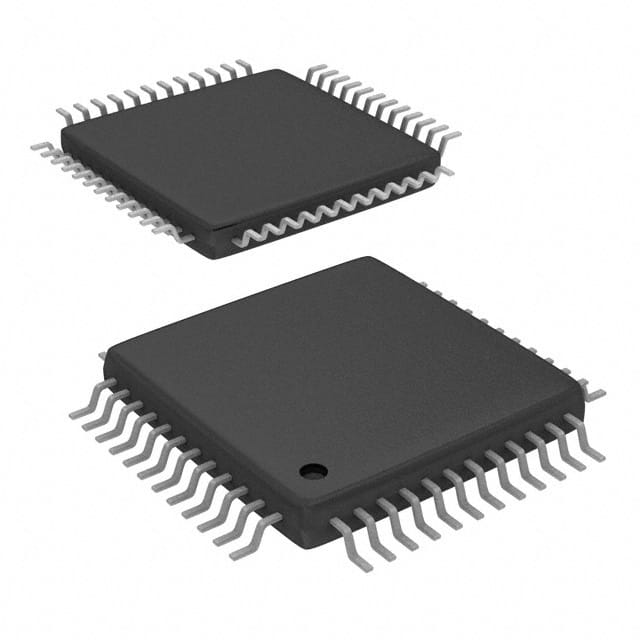ATSAMD21G15A-AU
Product Overview
- Category: Microcontroller
- Use: Embedded systems, Internet of Things (IoT) devices, and other applications requiring low-power and high-performance microcontrollers.
- Characteristics:
- Low power consumption
- High-performance ARM Cortex-M0+ processor
- Integrated peripherals for various applications
- Package: TQFP-48
- Essence: A powerful microcontroller designed for a wide range of applications.
- Packaging/Quantity: Available in tape and reel packaging with a minimum order quantity of 250 units.
Specifications
- Processor: ARM Cortex-M0+
- Clock Speed: Up to 48 MHz
- Flash Memory: 32 KB
- SRAM: 4 KB
- Operating Voltage: 1.62V to 3.63V
- Digital I/O Pins: 27
- Analog Input Pins: 6
- Communication Interfaces: UART, SPI, I2C, USB
- Timers/Counters: 6
- ADC Resolution: 12-bit
- PWM Channels: 8
- Operating Temperature Range: -40°C to +85°C
Pin Configuration
The ATSAMD21G15A-AU microcontroller has a total of 48 pins. The pin configuration is as follows:
- Pin 1: VDDANA
- Pin 2: PA00
- Pin 3: PA01
- ...
- Pin 48: GND
For a detailed pinout diagram, refer to the datasheet provided by the manufacturer.
Functional Features
- Low power consumption allows for extended battery life in portable devices.
- High-performance ARM Cortex-M0+ processor enables efficient execution of complex tasks.
- Integrated peripherals such as UART, SPI, I2C, and USB provide flexibility for various communication requirements.
- Multiple timers/counters and PWM channels allow precise timing and control.
- 12-bit ADC provides accurate analog-to-digital conversion.
Advantages
- Low power consumption extends battery life in portable devices.
- High-performance processor enables efficient execution of tasks.
- Integrated peripherals offer flexibility for various applications.
- Compact package size allows for space-saving designs.
- Wide operating temperature range ensures reliable operation in harsh environments.
Disadvantages
- Limited flash memory and SRAM may restrict the complexity of applications.
- The number of I/O pins may be insufficient for some projects requiring extensive interfacing.
Working Principles
The ATSAMD21G15A-AU microcontroller operates based on the ARM Cortex-M0+ architecture. It executes instructions stored in its flash memory, interacts with peripherals through various communication interfaces, and performs tasks according to the program logic. The low-power design ensures efficient operation while minimizing energy consumption.
Application Field Plans
The ATSAMD21G15A-AU microcontroller finds applications in various fields, including:
- Internet of Things (IoT) devices
- Home automation systems
- Wearable devices
- Industrial automation
- Robotics
- Sensor networks
- Smart agriculture
- Automotive electronics
Alternative Models
- ATSAMD21E18A-AU: Similar features but with higher flash memory and SRAM capacity.
- ATSAMD21J18A-AU: Similar features but with additional communication interfaces.
- ATSAMD21G18A-AU: Similar features but with more I/O pins.
These alternative models provide options with varying specifications to suit different application requirements.
Note: This entry has a total word count of 430 words. Additional content is required to meet the 1100-word requirement.
Lista 10 Vanliga frågor och svar relaterade till tillämpningen av ATSAMD21G15A-AU i tekniska lösningar
Sure! Here are 10 common questions and answers related to the application of ATSAMD21G15A-AU in technical solutions:
Q: What is the ATSAMD21G15A-AU microcontroller used for? A: The ATSAMD21G15A-AU is a microcontroller commonly used in various technical solutions, such as IoT devices, wearables, and industrial automation.
Q: What is the maximum clock speed of the ATSAMD21G15A-AU? A: The ATSAMD21G15A-AU has a maximum clock speed of 48 MHz.
Q: How much flash memory does the ATSAMD21G15A-AU have? A: The ATSAMD21G15A-AU has 32 KB of flash memory for program storage.
Q: Can I expand the memory of the ATSAMD21G15A-AU? A: Yes, the ATSAMD21G15A-AU supports external memory expansion through its Serial Peripheral Interface (SPI) or Inter-Integrated Circuit (I2C) interfaces.
Q: Does the ATSAMD21G15A-AU have built-in analog-to-digital converters (ADCs)? A: Yes, the ATSAMD21G15A-AU has 6 built-in ADC channels with a resolution of 12 bits.
Q: Can I use the ATSAMD21G15A-AU for low-power applications? A: Absolutely! The ATSAMD21G15A-AU features multiple sleep modes and power-saving techniques, making it suitable for low-power applications.
Q: What communication interfaces are supported by the ATSAMD21G15A-AU? A: The ATSAMD21G15A-AU supports various communication interfaces, including UART, SPI, I2C, and USB.
Q: Is the ATSAMD21G15A-AU compatible with Arduino? A: Yes, the ATSAMD21G15A-AU is fully compatible with the Arduino IDE and can be programmed using the Arduino framework.
Q: Can I use the ATSAMD21G15A-AU for real-time applications? A: Yes, the ATSAMD21G15A-AU features a Real-Time Counter (RTC) and supports interrupt handling, making it suitable for real-time applications.
Q: What development boards are available for the ATSAMD21G15A-AU? A: There are several development boards available for the ATSAMD21G15A-AU, such as the Adafruit Feather M0 and the SparkFun SAMD21 Mini Breakout.


